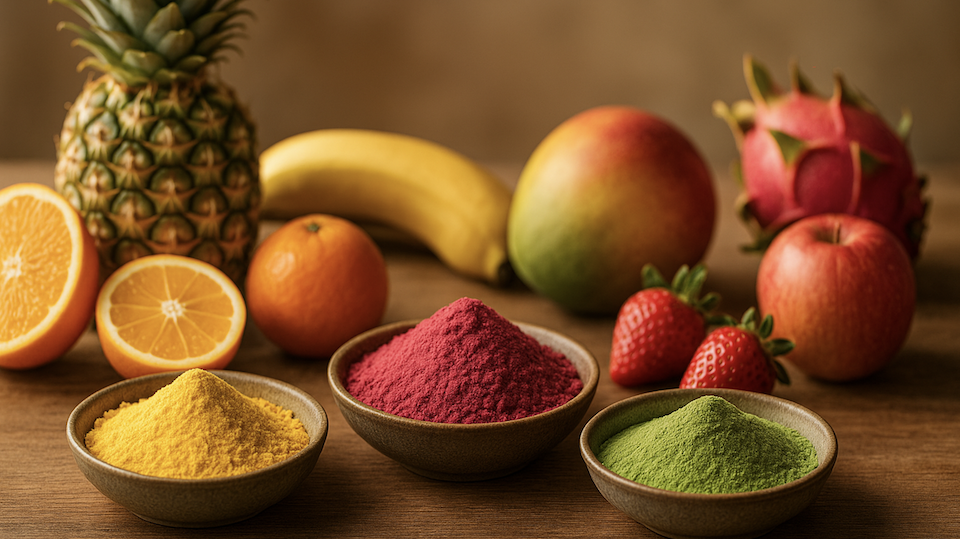Ever looked at a ripe banana and thought, “You’re great and all, but I wish I could carry you in my pocket”? No? Well, fruit powder makes that dream (and so many more) come true. Whether it’s mango, banana, or even dragon fruit (fancy!), fruit powders are shaking up industries from food to pharma to skincare. 💥
If you’ve got that entrepreneurial itch and you’re looking for a solid idea rooted in health, sustainability, and profitability—fruit powder manufacturing might just be your jam (or powder 😉).
Let’s peel back the layers and explore this business in depth—from techniques and tools to competition, scale, and success.
🛠️ First Things First: How is Fruit Powder Made?
There are two popular techniques for making fruit powders, and the one you choose can make all the difference:
🧊 1. Freeze Drying (Lyophilization)
- Process: Freeze fruit at low temps, then remove moisture by sublimation (solid → gas).
- Pros:
- Retains 90–95% of nutrients
- Best color, taste, aroma
- Long shelf life
- Cons:
- Expensive machinery
- Slower processing time
- Higher power consumption
- Ideal For: Premium products, exports, wellness brands
🌪️ 2. Spray Drying
- Process: Fruit pulp is sprayed into a chamber with hot air—turns into powder instantly.
- Pros:
- Faster and cheaper
- Suitable for large volumes
- Cons:
- Loss of heat-sensitive nutrients
- May need added carriers (like maltodextrin)
- Ideal For: Mass market F&B products, dairy mixes
Bonus: Some also use drum drying or air drying for more niche products. But freeze and spray are the top runners.
🏁 What’s the Market Saying?
India’s fruit powder market is heating up. Let’s look at the numbers (not the boring kind, promise):
📊 Competition Snapshot (India):
| Company Name | Technique | Products | USP |
|---|---|---|---|
| Aarkay Food | Spray Drying | Fruit & veggie powders | Wide product base |
| Satv Bio | Freeze Drying | Organic powders | Premium segment |
| Vikram Enterprises | Mixed | Custom B2B blends | Bulk supplier |
| Nutriberry | Freeze Drying | D2C fruit powders | Health & fitness niche |
Despite these players, the market is still nascent and fragmented. Most focus on B2B or exports. There’s huge room for a retail/D2C brand with unique blends and transparency.
🧭 Scaling It: Should You Go Local or Central?
Ah, the great Indian scale debate. Let’s break it down.
🏭 Local Manufacturing Units:
- Pros: Low logistics cost, fresher fruit, rural employment, FPO tie-ups
- Cons: May lack sophisticated tech, quality control challenges
- Best For: Niche, organic, or region-specific powders
🚛 Centralized Manufacturing:
- Pros: High consistency, economies of scale, better automation
- Cons: High transport cost of raw fruit (which is bulky and perishable)
- Best For: Export-focused or large-scale B2B
Pro Tip: Start local → standardize processes → build satellite units later. Think “franchise of factories” not one mega plant.
🥕 Beyond Fruits: Don’t Ignore Veggie Powders!
Your mango factory doesn’t have to stop at mangoes. Here’s where your setup can multitask:
- Beetroot powder – for smoothies, natural color
- Spinach powder – for health blends and bakery
- Garlic/onion powder – for seasoning, masalas
- Tomato powder – for ketchup, soups, noodles
- Carrot, moringa, turmeric – for health brands and ayurvedic uses
These use the same drying, grinding, and packing lines—just with better smell control (nobody wants banana-flavored garlic, right?).
🔐 The Real Risks (and How to Manage Them Like a Pro)
Before you dive headfirst into fruity profits, here are a few real-world pits to watch out for:
⚠️ 1. Seasonal Raw Material:
Fruits are seasonal and price-sensitive. Overproduction = waste; underproduction = idle machines.
What to do: Build a network of sourcing partners. Invest in cold storage. Diversify fruits.
⚠️ 2. Moisture + Microbes = Doom
One humidity mistake, and boom—fungal mess.
What to do: Invest in proper dryers, dehumidifiers, sealed storage. Get HACCP-certified from day one.
⚠️ 3. Weak Branding = No Shelf Recall
Unbranded powders are just another commodity.
What to do: Focus on storytelling, design, use cases. Build a brand, not just a powder.
⚠️ 4. Over-Scaling Without Demand
It’s tempting to go big fast—but powder doesn’t sell itself.
What to do: Start lean, validate in your city, build local love, then scale.
⚠️ 5. Regulatory Oversight
FSSAI is mandatory. Don’t mess around with food safety.
💡 Fundamentals to Nail from Day One
If you take away just five things, let it be these:
- Start with 2–3 fruits max. Test, learn, iterate.
- Go direct-to-retailer initially. Better margins, faster feedback.
- Use your byproducts. Fruit peels = compost, natural dyes, or biofuel.
- Create blends. Don’t sell mango. Sell “Sunrise Smoothie Mix”. 🌅
- Make content your marketing. Recipes, health hacks, reels = reach.
👑 Final Word: Is It Worth It?
If you love the idea of building something real, rooted in sustainability, wellness, and local empowerment— this is a legit business idea.
You can start small (₹25–30L), scale smart, and expand into global markets. It’s not without its risks—but with the right fundamentals, this could be the kind of business that lets you sleep well, earn better, and maybe even make your city a little greener. 🌍
And let’s face it—any business where your product smells like mango is better than most! 😉
